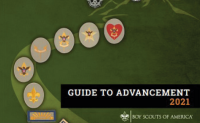 Most troops have a library of merit badge pamphlets and other information for the Scouts to use in going about their activities. It’s maintained by a troop librarian – a youth position of responsibility – and is primarily run by and for the Scouts.
Most troops have a library of merit badge pamphlets and other information for the Scouts to use in going about their activities. It’s maintained by a troop librarian – a youth position of responsibility – and is primarily run by and for the Scouts.
There’s another library that every troop should have – one for the adult leadership to consult.
We wrote earlier about the responsibilities of the committee chair. Among the responsibilities of a unit’s committee chair is the rather vague but rather ominous duty to interpret national and local policies to the unit.
Just how do you go about doing this?
A reader with several years of pack and troop leader experience, but new to the role of committee chair, asked me that question recently.
The simple answer: Do your best, and look up the rest.
One of the most important talents a person can have is the ability to find out things. Nobody is expected to know it all, but a resourceful person knows where to look to find the answers. And the Boy Scouts of America gives us an abundance of publications and resources to do just that.
When it comes to the myriad policies and guidelines of the BSA, there’s no one good place to look and no single reference book that tells it all. The information you need to know is found in many different places. Here’s a rundown on the references you should have in your personal or unit library.
- The Troop Committee Guidebook is a basic introduction to troop committee functions. It covers the structure of the committee, the functions of the various members, and contains important procedures. It’s item 616928, which you can find at your Scout Shop or order from www.scoutstuff.org. It’s not available in either a free or paid digital download.
- Also not available online are the two volumes of the newly-revised Troop Leader Guidebook. These are recent replacements for the Scoutmaster Handbook and cover things like troop meetings, uniforms and insignia, community service, training youth leaders and the outdoor program. Volume 1 is item 616729 and volume 2 is item 616835, online or at your Scout Shop.
- The Guide to Safe Scouting, published annually and maintained online. It covers Scouting safety from aquatics to power tools. Every Scouter should be familiar with the information in this publication. You can purchase the book or download the guide and keep it on your mobile device.
- Boy Scout Requirements, published annually and maintained online. This lists rank, merit badge and special award requirements throughout Boy Scouting. Having a printed copy is convenient so you don’t have to look in many places to find advancement requirements.
- The Guide to Advancement, published every two years and maintained online. The current revision is from 2015. This covers all aspects of advancement, written in a clear, easy to understand manner. Advancement probably generates more questions than any other topic, and this booklet covers them well.
- The Guide to Awards and Insignia describes exactly how the uniform is worn and how insignia are displayed on it. It goes beyond the basic layout and covers all insignia available at all levels of Scouting. Available online or in your local Scout Shop.
- And of course the Scout Handbook is the essential reference for youth members but also has program information that could help answer questions about how things are done.
In addition to the printed publications, one of the best connections you can make is with your unit commissioner and your district unit-serving executive. Get to know these people (you’ll usually find them at the monthly district Roundtable). When you have a question and can’t find the answer in a BSA publication, your commissioner can find the answers.
This post first appeared on Bobwhite Blather.



